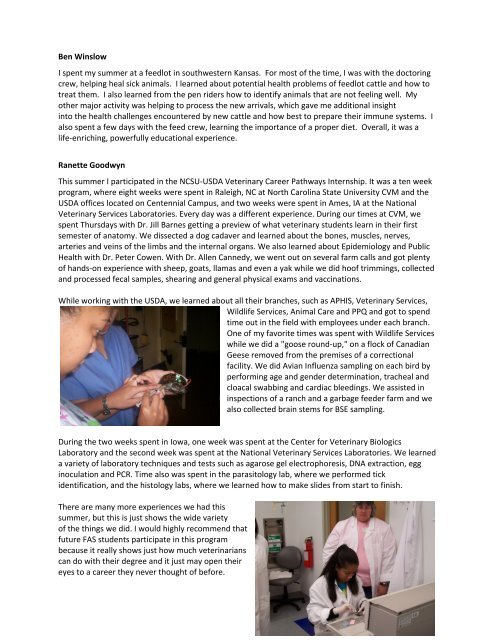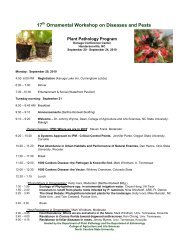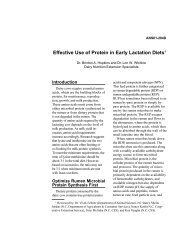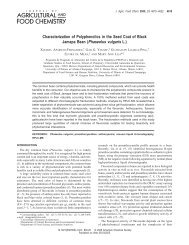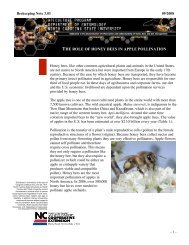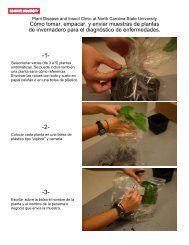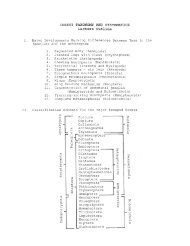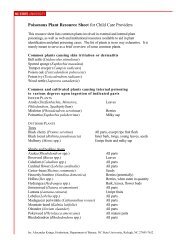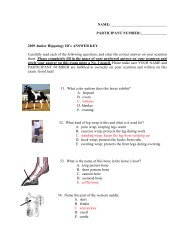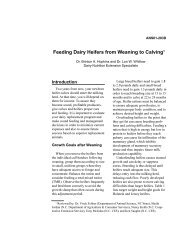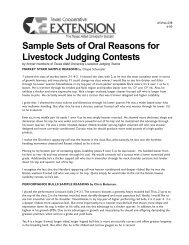Summer Internships 2009 - North Carolina State University
Summer Internships 2009 - North Carolina State University
Summer Internships 2009 - North Carolina State University
You also want an ePaper? Increase the reach of your titles
YUMPU automatically turns print PDFs into web optimized ePapers that Google loves.
Ben Winslow<br />
I spent my summer at a feedlot in southwestern Kansas. For most of the time, I was with the doctoring<br />
crew, helping heal sick animals. I learned about potential health problems of feedlot cattle and how to<br />
treat them. I also learned from the pen riders how to identify animals that are not feeling well. My<br />
other major activity was helping to process the new arrivals, which gave me additional insight<br />
into the health challenges encountered by new cattle and how best to prepare their immune systems. I<br />
also spent a few days with the feed crew, learning the importance of a proper diet. Overall, it was a<br />
life‐enriching, powerfully educational experience.<br />
Ranette Goodwyn<br />
This summer I participated in the NCSU‐USDA Veterinary Career Pathways Internship. It was a ten week<br />
program, where eight weeks were spent in Raleigh, NC at <strong>North</strong> <strong>Carolina</strong> <strong>State</strong> <strong>University</strong> CVM and the<br />
USDA offices located on Centennial Campus, and two weeks were spent in Ames, IA at the National<br />
Veterinary Services Laboratories. Every day was a different experience. During our times at CVM, we<br />
spent Thursdays with Dr. Jill Barnes getting a preview of what veterinary students learn in their first<br />
semester of anatomy. We dissected a dog cadaver and learned about the bones, muscles, nerves,<br />
arteries and veins of the limbs and the internal organs. We also learned about Epidemiology and Public<br />
Health with Dr. Peter Cowen. With Dr. Allen Cannedy, we went out on several farm calls and got plenty<br />
of hands‐on experience with sheep, goats, llamas and even a yak while we did hoof trimmings, collected<br />
and processed fecal samples, shearing and general physical exams and vaccinations.<br />
While working with the USDA, we learned about all their branches, such as APHIS, Veterinary Services,<br />
Wildlife Services, Animal Care and PPQ and got to spend<br />
time out in the field with employees under each branch.<br />
One of my favorite times was spent with Wildlife Services<br />
while we did a "goose round‐up," on a flock of Canadian<br />
Geese removed from the premises of a correctional<br />
facility. We did Avian Influenza sampling on each bird by<br />
performing age and gender determination, tracheal and<br />
cloacal swabbing and cardiac bleedings. We assisted in<br />
inspections of a ranch and a garbage feeder farm and we<br />
also collected brain stems for BSE sampling.<br />
During the two weeks spent in Iowa, one week was spent at the Center for Veterinary Biologics<br />
Laboratory and the second week was spent at the National Veterinary Services Laboratories. We learned<br />
a variety of laboratory techniques and tests such as agarose gel electrophoresis, DNA extraction, egg<br />
inoculation and PCR. Time also was spent in the parasitology lab, where we performed tick<br />
identification, and the histology labs, where we learned how to make slides from start to finish.<br />
There are many more experiences we had this<br />
summer, but this is just shows the wide variety<br />
of the things we did. I would highly recommend that<br />
future FAS students participate in this program<br />
because it really shows just how much veterinarians<br />
can do with their degree and it just may open their<br />
eyes to a career they never thought of before.


